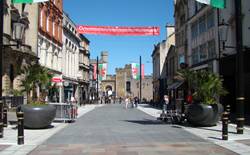 |
RS Home |
Bath |
|
|
Over 60 Attractions in and around Cardiff. |
| Hotels | Large Images | What's On |
| B&Bs | Self Catering | Hostels |
| Airport | Restaurants | Cinemas |
| Golf | Night Clubs | Theatres |
| Shops | CityBus Tours | Casinos |
|
Cardiff is the largest city in Wales, home to the Welsh Government and the Principality Stadium for major sporting and entertainment events, formerly the Millennium Stadium. William the Conqueror began the building of Cardiff Castle in 1081, on the site of an old Roman Fort. The town grew around the Castle and Port. Cardiff was caught up in many battles between 1081 and the early 1400s. These battles were an attempt to keep English Kings from ruling Wales, known as the Anglo Welsh Wars. The Act of Union between England and Wales in 1536 led the two countries merging. Scotland merged with England and Wales in 1707, then Ireland merged in 1800, leading to the Kingdom of Great Britain. 1648, during the Second English Civil War, the Battle of St Fagans, 5 miles west of Cardiff, saw the Parliamentarian forces of Oliver Cromwell defeat the Royalists then take control of Wales. This was the last major battle in Wales. 1820s, Cardiff docks were built up by the wealthy Scots landowner John Crichton-Stuart, 2nd Marquess of Bute, descendant of King Robert the Bruce. Bute increased his wealth through exporting Coal and Iron from Cardiff. Bute also took control of Cardiff Castle at that time, transforming it into a stately home. 1880s, Cardiff had become the largest town in Wales, shipping more Coal than any other Port in the world. 1905, Cardiff was made a city. 1955, Cardiff became the capital of Wales. There had been no capital city in Wales until this time. 1960s, Coal exports had virtually ceased, then the Moors Steelworks closed in 1978, leading to the Docks being run down. 1990s, the Docks at Cardiff undergoe transformation into an area for recreation, museums, shopping, and sea view apartments. The area is now known as Cardiff Bay. 1998, the National Assembly for Wales is introduced to give the Welsh power to make Legislation in Wales. 2001, The Senedd (National Assembly Building) is built at Cardiff Bay in an award winning architectural design. wiki/Cardiff for more History of Cardiff.
|
